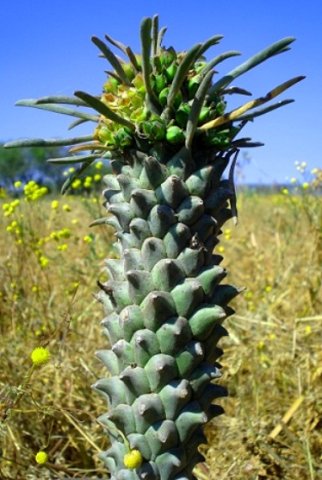Euphorbia clandestina

Author: Ivan Lätti
Photographer: Judd Kirkel Welwitch
Euphorbia clandestina, sometimes called the ostrich noors and in Afrikaans the volstruisnek (ostrich neck), grows one erect columnar stem to heights around 80 cm. Only rarely is a branched specimen found, the branching in the lower part.
The finely hairy leaves, dull turquoise in colour and long, narrow and keeled in shape, appear only in the top section of new growth. Below this part the stem is covered in a neat geometric pattern, spirals of evenly protruding tubercles where earlier leaves have all dropped off.
The small green and yellow flowers or cyathia more or less cover the available surface at the stem top among the leaves in winter or early spring. The green bracts around the cyathia will soon become yellow while green spherical, segmented fruits emerge inside them later, replacing the flowers.
The geographical spread of the species is in the central and eastern regions of the Western Cape, well represented in the Little Karoo.
The habitat is semi-arid, karoid scrub and renosterveld on stony slopes and flats in loamy soils. The species is not considered threatened in habitat early in the twenty first century.
And why clandestina? The word means hidden in Latin, referring to the cyathia that are hidden among the leaves (Frandsen, 2017; Smith, et al, 2017; Vlok and Schutte-Vlok, 2015; www.smsgrowers.com; iNaturalist; http://redlist.sanbi.org).

